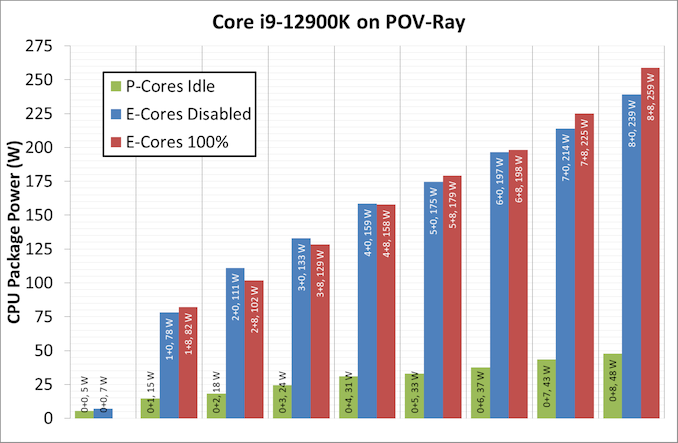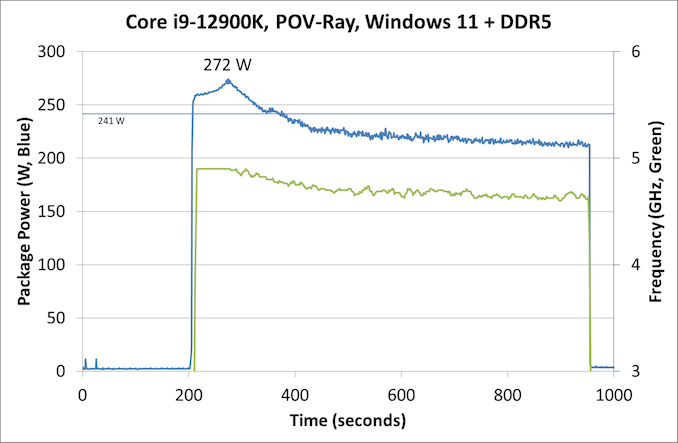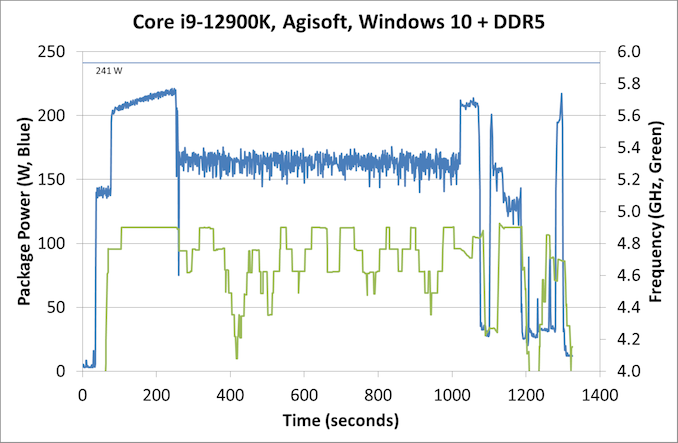The Intel 12th Gen Core i9-12900K Review: Hybrid Performance Brings Hybrid Complexity
by Dr. Ian Cutress & Andrei Frumusanu on November 4, 2021 9:00 AM ESTPower: P-Core vs E-Core, Win10 vs Win11
For Alder Lake, Intel brings two new things into the mix when we start talking about power.
First is what we’ve already talked about, the new P-core and E-core, each with different levels of performance per watt and targeted at different sorts of workloads. While the P-cores are expected to mimic previous generations of Intel processors, the E-cores should offer an interesting look into how low power operation might work on these systems and in future mobile systems.
The second element is how Intel is describing power. Rather than simply quote a ‘TDP’, or Thermal Design Power, Intel has decided (with much rejoicing) to start putting two numbers next to each processor, one for the base processor power and one for maximum turbo processor power, which we’ll call Base and Turbo. The idea is that the Base power mimics the TDP value we had before – it’s the power at which the all-core base frequency is guaranteed to. The Turbo power indicates the highest power level that should be observed in normal power virus (usually defined as something causing 90-95% of the CPU to continually switch) situation. There is usually a weighted time factor that limits how long a processor can remain in its Turbo state for slowly reeling back, but for the K processors Intel has made that time factor effectively infinite – with the right cooling, these processors should be able to use their Turbo power all day, all week, and all year.
So with that in mind, let’s start simply looking at the individual P-cores and E-cores.
Listed in red, in this test, all 8P+8E cores fully loaded (on DDR5), we get a CPU package power of 259 W. The progression from idle to load is steady, although there is a big jump from idle to single core. When one core is loaded, we go from 7 W to 78 W, which is a big 71 W jump. Because this is package power (the output for core power had some issues), this does include firing up the ring, the L3 cache, and the DRAM controller, but even if that makes 20% of the difference, we’re still looking at ~55-60 W enabled for a single core. By comparison, for our single thread SPEC power testing on Linux, we see a more modest 25-30W per core, which we put down to POV-Ray’s instruction density.
By contrast, in green, the E-cores only jump from 5 W to 15 W when a single core is active, and that is the same number as we see on SPEC power testing. Using all the E-cores, at 3.9 GHz, brings the package power up to 48 W total.
It is worth noting that there are differences between the blue bars (P-cores only) and the red bars (all cores, with E-cores loaded all the time), and that sometimes the blue bar consumes more power than the red bar. Our blue bar tests were done with E-cores disabled in the BIOS, which means that there might be more leeway in balancing a workload across a smaller number of cores, allowing for higher power. However as everything ramps up, the advantage swings the other way it seems. It’s a bit odd to see this behavior.
Moving on to individual testing, and here’s a look at a power trace of POV-Ray in Windows 11:
Here we’re seeing a higher spike in power, up to 272 W now, with the system at 4.9 GHz all-core. Interestingly enough, we see a decrease of power through the 241 W Turbo Power limit, and it settles around 225 W, with the reported frequency actually dropping to between 4.7-4.8 GHz instead. Technically this all-core is meant to take into account some of the E-cores, so this might be a case of the workload distributing itself and finding the best performance/power point when it comes to instruction mix, cache mix, and IO requirements. However, it takes a good 3-5 minutes to get there, if that’s the case.
Intrigued by this, I looked at how some of our other tests did between different operating systems. Enter Agisoft:
Between Windows 10 and Windows 11, the traces look near identical. The actual run time was 5 seconds faster on Windows 11 out of 20 minutes, so 0.4% faster, which we would consider run-to-run variation. The peaks and spikes look barely higher in Windows 11, and the frequency trace in Windows 11 looks a little more consistent, but overall they’re practically the same.
For our usual power graphs, we get something like this, and we’ll also add in the AVX-512 numbers from that page:

Compared to Intel’s previous 11th Generation Processor, the Alder Lake Core i9 uses more power during AVX2, but is actually lower in AVX-512. The difficulty of presenting this graph in the future is based on those E-cores; they're more efficient, and as you’ll see in the results later. Even on AVX-512, Alder Lake pulls out a performance lead using 50 W fewer than 11th Gen.
When we compare it to AMD however, with that 142 W PPT limit that AMD has, Intel is often trailing at a 20-70 W deficit when we’re looking at full load efficiency. That being said, Intel is likely going to argue that in mixed workloads, such as two software programs running where something is on the E-cores, it wants to be the more efficient design.














474 Comments
View All Comments
mode_13h - Saturday, November 6, 2021 - link
On what basis do you reach that verdict? Based on your posts, I wouldn't trust you to run a corner shop, much less one of the biggest and most advanced tech & manufacturing companies on the planet.And where did they said it's "fused off"? AFAIK, all they said is that it's not available and this will not change. And we've seen no evidence of that being untrue.
Also, I think you're getting a bit too worked up over the messaging. In the grand scheme, that's not the decision that really matters.
SystemsBuilder - Saturday, November 6, 2021 - link
no I did no miss that. I'm just happy that ASUS found a way to enable it.Intel screwed up of course - battel between different departments and managers, marketing etc I'm sure - that's a given and did not think it was necessary to repeat that. And yes it is absurd - even incompetent.
Still I'm happy ASUS found it and exposed it, because, as I said they they actually seam to have gotten AVX-512 right in Golden cove.
Intel should of course work with Microsoft to get the scheduler to work with any E/P mix, make the support official, enable it in the base BIOS, have base BIOS sent over to all OEMs and lastly fire/reassign the idiot that took AVX-512 off the POR for Alder lake.
In any case it give me something to look forward to with Sapphire rapids which should come with more Golden cove P cores.
I only by ASUS boards so
SystemsBuilder - Saturday, November 6, 2021 - link
can't edit post so continuing:I only buy and use ASUS boards so for me it's fine but I sucks for others.
Also doubt that Pat was involved. Decisions were likely made before his arrival. I'm thinking about the Microsoft dependency. They would have needed to lock the POR towards Microsoft a while back to give MS enough time to get the scheduler and other stuff right...
Oxford Guy - Saturday, November 6, 2021 - link
The product was released on his watch, on these incompetent terms. Gelsinger is absolutely responsible. He now has a serious black mark on his leadership card. A competent CEO wouldn’t have allowed this situation to occur.This is an outstanding example of how the claim that only engineers make good CEOs for tech companies is suspect.
‘I only by ASUS boards so’
Lies of omission are lies.
SystemsBuilder - Saturday, November 6, 2021 - link
I totally agree that it goes against putting engineers in charge.for me the whole AVX-512 POR decision and "AVX-512 is fused off" message is coming out of a incompetent marketing department when they were still in charge.
Oxford Guy - Saturday, November 6, 2021 - link
‘when they were still in charge.’Gelsinger isn’t the CEO? Gelsinger wasn’t the CEO when Alder Lake was released? Marketeers outrank the CEO?
The buck stops with him.
The implication that having an engineer run a business makes said engineer a skilled businessperson is safely dead.
The success of Steve Jobs also problematized that claim well before this episode, as he was not an engineer.
SystemsBuilder - Saturday, November 6, 2021 - link
i think under the old "regime" marketing did out rank engineering so that the old CEO listened more to marketing than engineering (of course the CEO makes the decision but he takes input from various camps and that is what i mean with marketing "were still in charge"). A non-engineering educated CEO is particularly influenceable by marketing (especially if he/she has MBA with marketing specialization like the old CEO's). Hence the messaging decisions to "fuse it off" was likely heavily influenced by marketing who i think finally won over Engering. Pat had to inherit this decision but could not change i for windows 11 launch - it was too late.Oxford Guy - Saturday, November 6, 2021 - link
Of course he could change it. He’s the CEO.mode_13h - Saturday, November 6, 2021 - link
> so that the old CEO listened more to marketing than engineeringIn this case, the issue wouldn't be who the CEO listens to, but who gets to define the products. Again, the issue of AVX-512 in Alder Lake is something that would probably never rise to the attention of the CEO, in a company with $75B annual revenue, tens of thousands of employees at hundreds of sites, and many thousands of products in hundreds of different markets. OG apparently has no concept of what these CEOs deal with, on a day to day basis.
mode_13h - Saturday, November 6, 2021 - link
> Gelsinger wasn’t the CEO when Alder Lake was released?So what was he supposed to do? Do you think they run all PR material by the CEO? How would he have any time to make the important decisions, like about running the company and stuff?
It seems to me like you're just playing agent provocateur. I haven't even seen you make a good case for why this matters so much.